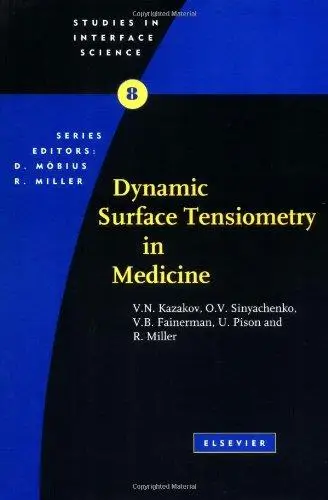Dynamic Surface Tensiometry in Medicine By Valery N. Kazakov, Oleg V. Sinyachenko, Valentin B. Fainerman, Ulrich Pison, Reinhard Miller, R. Mil
2000 | 388 Pages | ISBN: 0444504117 | PDF | 15 MB
2000 | 388 Pages | ISBN: 0444504117 | PDF | 15 MB
Human biological liquids contain numerous low- and high-molecular weight surfactants. The human organism contains interfaces with enormous surfaces. The physicochemical and biochemical processes taking place at these interfaces are extremely important for the vital functions of the organism as a whole, and the interfacial properties may reflect peculiarities of age and sex, health and disease. The present book is the first attempt to systematically present the results of dynamic and equilibrium surface tensions measurements of serum and urine samples that were obtained from healthy humans of various sex and age, and to compare these results with measurements of biological liquids obtained from patients suffering from various diseases or with measurements of amniotic fluid obtained from women at various stages of pregnancy.Pulmonary medicine, especially neonatology, has systematically used interfacial tensiometry for studying pulmonary surfactant. In this particular area, significant progress was achieved in the treatment of diseases related to alterations of the lung surfactant system. We believe that, similar to the progress in pulmonary medicine attributed to surface chemical studies of lung surfactant, progress in other medical branches could be expected through studies of interfacial characteristics of other human biological liquids.For several years the authors of this book have been engaged in studies aimed at the improvement of the maximum bubble pressure method, resulting in the development of computer controlled tensiometers which are capable of measuring dynamic surface tensions within a wide range of surface lifetime. In addition to the measurement techniques, a correct interpretation and analysis of the tensiometric data obtained is extremely important. The kinetic theory of adsorption from solutions, and the theory of equilibrium adsorption layers of surfactant/protein mixtures provide the basis for both the choice of the most characteristic parameters of tensiograms and the analysis of the results. Some theoretical models describing the adsorption of proteins are presented in Chapter 1. The main theoretical and experimental issues related to the maximum bubble pressure technique as applied to biological liquids are presented in Chapter 2. A more detailed discussion of the differences of the various methods in use for measuring dynamic surface tension of biological fluids is provided in Chapter 3. Chapter 4 gives data from patients with kidney disease, Chapter 5 from patients with rheumatic diseases, Chapter 6 with pulmonary diseases, Chapter 7 with diseases of the central nervous system, and Chapter 8 with neoplasms.Dynamic interface tensiometry of human biological liquids is a fascinating new method which deserves a broad use for prospective studies of various diseases.



